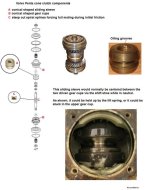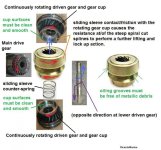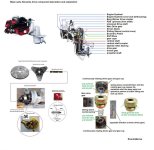As the title says I have a 1995 Cobalt 222 with a DP-D1 drive that shifts into gear really hard. The motor and drive have 371 hours. I purchased the boat from the original owner. The boat sat most of its life with little use. I was told that the boat was difficult to shift the last time the owner had it in the water. I had the original shifter replaced with a Teleflex and also replaced the throttle and shift cable. Engine and drive fluids were replaced before launching the boat. My previous boat had Alpha drives on it so I was familiar with the way that type of drive shifts. I have read that the Volvo drives shift with an audible "thud", not sure if that is the correct way to describe it. The drive on this boat bangs into gear. It goes into gear so hard that anyone in the boat can feel it. The boat idles a hair over 600 rpm so that isn't the problem. I thought that maybe the shift cable wasn't adjusted correctly so I disconnected the cable at the drive and shifted it by hand. No change. When turning the shifting mechanism on the drive by hand it takes great force to put the boat into gear. When trying to move back to neutral I can't do it by hand because the force it takes to turn the mechanism causes me to overshoot neutral and go into reverse. With all of this being said once underway there is zero vibration in the boat when either accelerating or at top end. Not sure where this puts me at this point. I spoke to a local VP mechanic and he told me this is the way the "swedish" VP drives shift and that it is normal. Could be but I find this hard to believe. Any help is appreciated.
Home
Outboard Motor Parts
Chrysler outboard parts Evinrude outboard parts Force outboard parts Honda outboard parts Johnson outboard parts Mariner outboard parts Mercury outboard parts Suzuki outboard parts Tohatsu outboard parts Yamaha outboard partsInboard & Sterndrive Engine Parts
Chrysler Marine inboard parts Crusader Marine parts MerCruiser sterndrive parts OMC sterndrive parts Pleasurecraft Marine parts Volvo Penta marine parts + MoreAll Engine Brands
All Manuals HomeOutboard Repair Manuals
Chrysler outboard manuals Evinrude outboard manuals Force outboard manuals Honda outboard manuals Johnson outboard manuals Mariner outboard manualsMercury outboard manuals Nissan outboard manuals Suzuki outboard manuals Tohatsu outboard manuals Yamaha outboard manuals
Inboard & Sterndrive Engine Manuals
MerCruiser sterndrive manuals OMC sterndrive manuals Volvo Penta marine engine manualsPlease Note
MarineEngine.com does not offer troubleshooting assistance or repair advice by email or by telephone.
You are invited to join our public Boat Repair Forum to seek assistance from other members.
You may also visit the Boat Motor Manuals section of our site to obtain a service manual.




